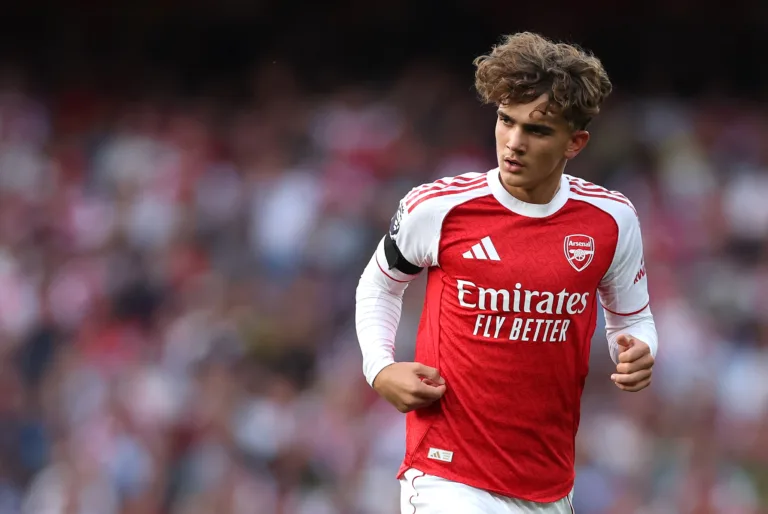Nick Woltemade: The 6’6 Giant Who is Ready to Take Over
Nick Woltemade might not have been the headline act going into the Euro Under-21s, but by the end of the group stage, his name was everywhere. Towering above defenders with a calmness that belied his age, the Stuttgart forward made every touch count, bringing a composure and intelligence that stood out amid countless other prospects.
While the tournament clashed awkwardly with the Club World Cup, it didn’t stop fans and scouts alike from paying close attention to the emerging stars on show. And among the many bright sparks, Geovanny Quenda’s effortless dribbling, Thierney Barry’s brute force, and Djaoui Cisse’s flair, it was Nick Woltemade’s presence that was the most interesting profile of the lot.
And it was this presence that has since garnered interest from both Chelsea and Everton, amongst other clubs across Europe.
The Making of Nick Woltemade: From Bremen to Stuttgart
Nick Woltemade averaged 20 goals last season for Stuttgart in the Bundesliga. He is currently on a 5-goal lead for Germany at the Euro under-21 after representing them at the Senior team during the just-concluded Nations League. At the moment, Woltemade is on four goals and he is in the fight for the Golden Boot. What do we need to know about him and what he does and how his profile can aid the tactical setup of the team?
Woltemade is a product of the Werder Bremen academy; he began his football journey at TS Woltmershausen in 2009 before moving to the Werder Bremen academy in 2010. At Werder Bremen youth academy he scored 18 goals and 8 assists in the Under 17 Bremen system. He moved to the under-19 team, where he scored 7 goals in 8 matches. Due to the brilliant performance, he earned a call to the senior team against Bayer Leverkusen on the 11th of January, 2020. He cemented his place in the Bremen first team against Augsburg, becoming the youngest player at the age of 17 years, 11 months and 16 days.
He joined SV Elseberg on loan in 2022 despite the inability to secure a place in the Senior team likewise featuring in the third division of the German League. After a series of 32 games and 10 goals in the 2022/23 season, he went back to Werder Bremen and spent another season with them. At the end of the 23/24 season at Bremen, he moved to VfB Stuttgart for the 24/25 season, where we considered it a breakout year for him.
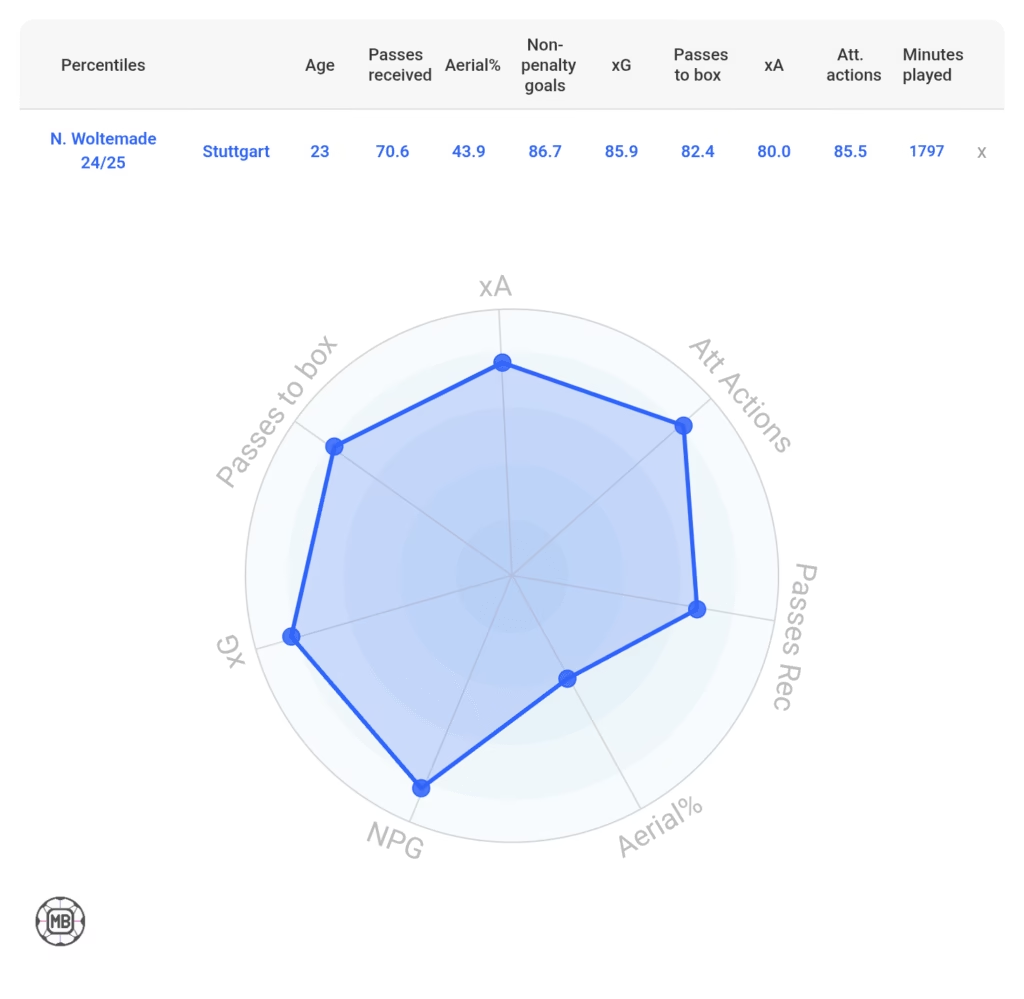
Woltemade scored 17 goals and made 3 assists this season. According to a stat in the Bundesliga, he scored 12 actual goals; he played 3 penalties and scored two out of those penalties. He played an average of 44 shots, won 297 tackles and won 45 aerial duels. With sprints averaged at 33, intensive runs at 1144, and distance covered at the average of 203 km at the speed of 32 km/h, we look into what makes Woltemade a perfect run for any team with a height of 1.98.
The Tactical Profile & Dynamics of Nick Woltemade
Woltemade is described by several Bundesliga analysts as a shadow striker that can involve himself in possession phases and often adapt a free-roaming presence when there is a less mobile striker upfront, which also means he can support, strike or play the false in a shape. He excels in linking play, creating chances, and finishing effectively, making him a valuable asset in possession-based systems. While strong in tight spaces and with a good first touch, he’s still developing his aerial prowess, despite having scored some impressive headers.
According to Adam Khan, a German Football consultant these similarities are modelled on the Dutch Legend, Robin Van Persie. He is a player who can dribble in tight spaces with the pace, mobility and skill to beat defenders and build a capability to maintain the ball even when he is under pressure. He is fluid on the ball and he combines it with a technical elegance despite his stature. He can switch play even while he is under pressure. With this capability he can open an attack, time his movement and turn in after receiving a ball to the back of the goal.
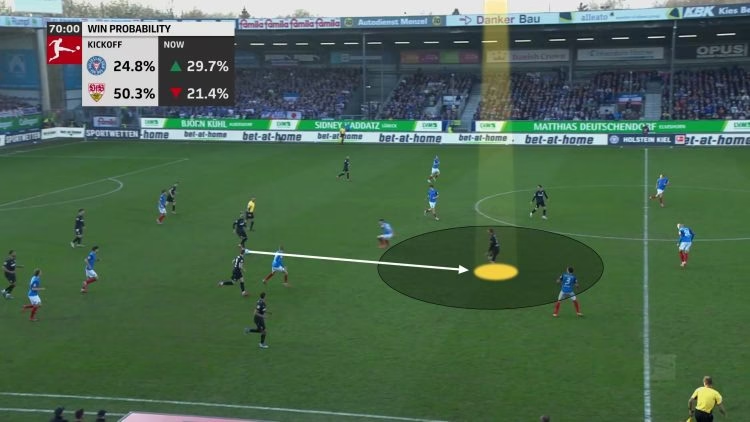
Woltemade can manipulate the ball, moving to a position where he can shoot on and off target, which could be a real threat for opposing goalkeepers. He is flexible in movement and he knows when to pick, switch and change his movement in a build-up phase.
He also has the ability to turn and face off against a defender, beating them with the required speed. His ability to play and pick a ball in the Midfield zone are traits of versatility when he is in possession or out of possession in an opponent’s lane, either waiting to receive or create. He can play as a second striker, a target man, or even drop into midfield, making him a versatile option for different tactical setups.
Despite a height of 1.98m, he finds it difficult with aerial balls, as he doesn’t have the strength, which can sometimes be covered up with a much more physical partner. He can sometimes find it difficult to get into goal-scoring positions, which can be improved. While he uses his body well for shielding, he can further utilise his size to create more opportunities and cause more problems for defenders.
Tactical Role of Nick Woltemade
Woltemade thrives in systems that emphasise possession-based football and fluid attacking movements. His ability to combine with teammates, create space, and finish chances makes him a valuable asset in these systems. He can play as a second striker, a false nine, or even drop into a deeper midfield role to influence the game from different areas. He is also capable of playing as a lone striker, using his hold-up play and link-up ability to bring other players into the game.
Woltemade has been crucial to Sebastian Hoeneß‘s tactical identity of utilising formations that feature a three-player midfield; notably, this has been the 4-2-3-1 shape, which he has used extensively at Hoffenheim and Stuttgart. He also used a 3-5-2 at Hoffenheim; while at Stuttgart, he has evolved to using a 4-4-2.
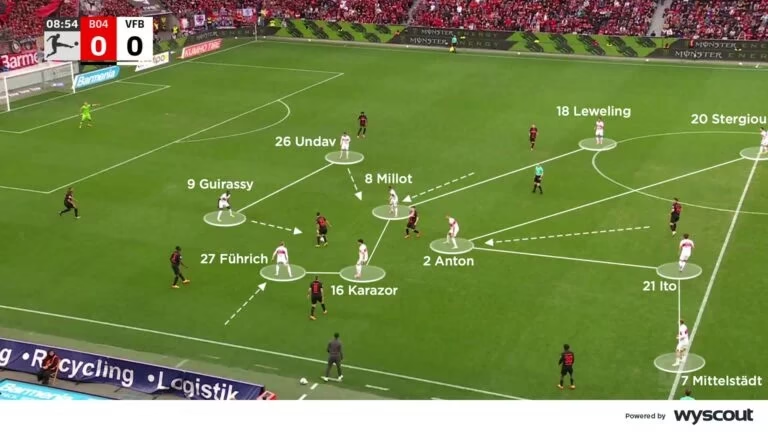
At Stuttgart, with Serhou Guirassy leading the line in 2023/24, the 4-2-3-1 initially operated similarly to at Hoffenheim. Supporting underneath or alongside was Deniz Undav, who had the ability to play as a nine or 10. With this shape, Stuttgart were able to fluidly change shape just like Hoffenheim, except this time between a 4-2-3-1 and a 4-4-2.
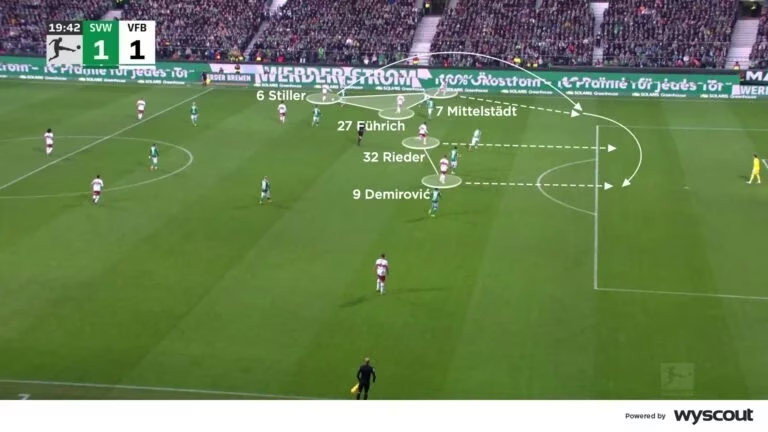
Stuttgart’s high pressing has often focused on jumping centrally up the pitch, often in a 4-4-2 or 4-2-3-1. The first line has screened central passes and pressed forward, often joined by narrowed wingers.
With wide pairings at Stuttgart, there has also been more licence for the forwards to drop into midfield to hold, link, connect or stretch in behind. This has helped to increase crossing deliveries in Hoeneß’s second season, with the tactic of pulling out opponents first to then exploit the spaces while not reducing their increasingly threatening central attacks.
With the idea Hoeneß brought with him from his time at Hoffenheim, albeit using a different attacking structure at Stuttgart. Nick Woltemade in particular has benefited, as he is used in a similar manner to Kramaric.
He can play in the number 10 spaces and as a second number nine, allowing Hoeneß’s side to seamlessly change attacking shapes, which has improved him as a player.








